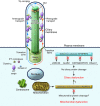Lights on for aminopeptidases in cystic kidney disease
- PMID: 20179346
- PMCID: PMC2827971
- DOI: 10.1172/JCI42378
Lights on for aminopeptidases in cystic kidney disease
Abstract
While erudite cell biologists have for many decades described singular immotile appendages known as primary cilia to be present on most cells in our bodies, cilial function(s) long remained an enigma. Driven largely by an ever increasing number of discoveries of genetic defects in primary cilia during the past decade, cilia were catapulted from a long lasting existence in obscurity into the bright spotlight in cell biology and medicine. The study by O'Toole et al. in this issue of the JCI adds a novel "enzymatic" facet to the rapidly growing information about these little cellular tails, by demonstrating that defects in the XPNPEP3 gene, which encodes mitochondrial and cytosolic splice variants of X-prolyl aminopeptidase 3, can cause nephronophthisis-like ciliopathy. Future studies are in order now to elucidate the cystogenic pathways affected by disrupted enzymatic function of XPNPEP3 in cilia-related cystogenic diseases.
Figures


Comment on
-
Individuals with mutations in XPNPEP3, which encodes a mitochondrial protein, develop a nephronophthisis-like nephropathy.J Clin Invest. 2010 Mar;120(3):791-802. doi: 10.1172/JCI40076. Epub 2010 Feb 22. J Clin Invest. 2010. PMID: 20179356 Free PMC article.
Similar articles
-
Individuals with mutations in XPNPEP3, which encodes a mitochondrial protein, develop a nephronophthisis-like nephropathy.J Clin Invest. 2010 Mar;120(3):791-802. doi: 10.1172/JCI40076. Epub 2010 Feb 22. J Clin Invest. 2010. PMID: 20179356 Free PMC article.
-
Structure of the human aminopeptidase XPNPEP3 and comparison of its in vitro activity with Icp55 orthologs: Insights into diverse cellular processes.J Biol Chem. 2017 Jun 16;292(24):10035-10047. doi: 10.1074/jbc.M117.783357. Epub 2017 May 5. J Biol Chem. 2017. PMID: 28476889 Free PMC article.
-
Cilia, mitochondria, and cardiac development.J Clin Invest. 2019 Jun 17;129(7):2666-2668. doi: 10.1172/JCI129827. eCollection 2019 Jun 17. J Clin Invest. 2019. PMID: 31205030 Free PMC article.
-
Cystic kidney diseases: many ways to form a cyst.Pediatr Nephrol. 2013 Jan;28(1):33-49. doi: 10.1007/s00467-012-2221-x. Epub 2012 Jun 27. Pediatr Nephrol. 2013. PMID: 22736301 Free PMC article. Review.
-
Nephronophthisis-associated ciliopathies.J Am Soc Nephrol. 2007 Jun;18(6):1855-71. doi: 10.1681/ASN.2006121344. Epub 2007 May 18. J Am Soc Nephrol. 2007. PMID: 17513324 Review.
Cited by
-
Mutational burden of XPNPEP3 leads to defects in mitochondrial complex I and cilia in NPHPL1.iScience. 2023 Jul 23;26(8):107446. doi: 10.1016/j.isci.2023.107446. eCollection 2023 Aug 18. iScience. 2023. PMID: 37599822 Free PMC article.
-
Nephronophthisis: A review of genotype-phenotype correlation.Nephrology (Carlton). 2018 Oct;23(10):904-911. doi: 10.1111/nep.13393. Epub 2018 Jun 21. Nephrology (Carlton). 2018. PMID: 29717526 Free PMC article. Review.
-
Role of primary cilia in non-dividing and post-mitotic cells.Cell Tissue Res. 2017 Jul;369(1):11-25. doi: 10.1007/s00441-017-2599-7. Epub 2017 Mar 30. Cell Tissue Res. 2017. PMID: 28361305 Free PMC article. Review.
References
Publication types
MeSH terms
Substances
Grants and funding
LinkOut - more resources
Full Text Sources
Medical
Research Materials
Miscellaneous

